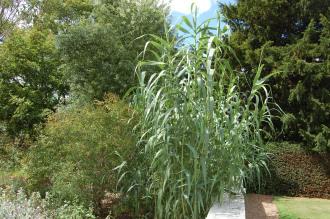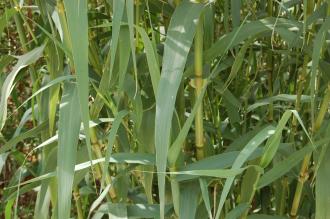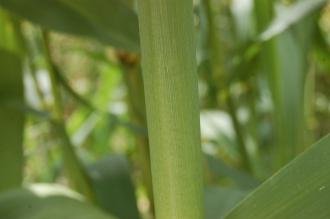
Arundo donax (15/08/2015, Kew Gardens, London)
Position: Full sun
Flowering period: Late summer
Soil: Moist, well drained
Eventual Height: 6m
Eventual Spread: 6m
Hardiness: 6b, 7a, 7b, 8a, 8b, 9a, 9b, 10a, 10b
Family: Poaceae
Arundo donax is a fast growing deciduous grass specicies with an upright habit. Its green/ gray leaves are lanceolate with entire margins, up to 60cm long and 6cm across. Its stems are hollow and up to 5cm across. Its light green flowers are upright feathery plumes which are up to 60cm long and generally sterile. Its roots contain rhizomes which aids its spread, this is this plant’s main method of propagation, these roots may reach a depth of up to 1m.

Arundo donax Leaf (15/08/2015, Kew Gardens, London)
Arundo donax, commonly known as Giant Cane, Spanish Cane, River Reed, Wild Cane, Carrizo or Giant Reed, is native to the Mediterranean region and middle east Asia. In it native habitat it forms dense stands on sand dunes, floodplains, wetlands and river banks. This plant is one of the fastest growing terrestrial plants in the world. In non native communities this plant may outgrow native plant, dominating the ecosystem. As a consistence this plant is considered an invasive plant in a number of coutries and states. This plant is increasingly being used as a biofuel.
The etymological root of the binomial name Arundo is from the Latin meaning ‘reed’. Donax is derived from the ancient Greek meaning ‘reed’.
The landscape architect may find Arundo donax useful as a fast growing grass species which has an erosion control capability. It may also be used as part of a tropical type planting scheme. Care should be taken when specifying this plant as it is potentially invasive and will dominate a habitat.

Arundo donax Stem (15/08/2015, Kew Gardens, London)
Ecologically, Arundo donax is of little value in the UK.
Arundo donax prefers moist, fertile, well-drained soils although it prefers wet soils. It tolerates most pH of soil.
Arundo donax requires some maintenance. Canes may be cut to ground level during late winter to promote a tidy appearance. A root barrier may be installed at the time of planting to prevent the excessive spread of this plant.

Landscape Architecture

